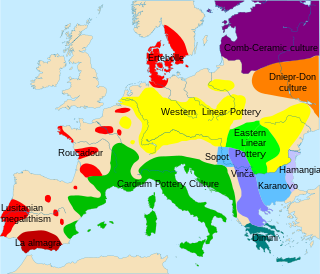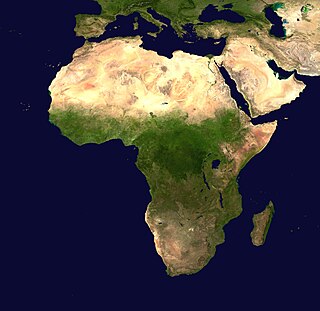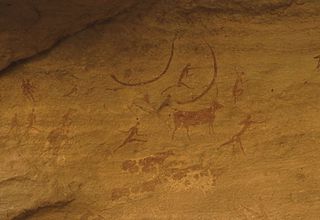
The Funnel(-neck-)beaker culture, in short TRB or TBK was an archaeological culture in north-central Europe. It developed as a technological merger of local neolithic and mesolithic techno-complexes between the lower Elbe and middle Vistula rivers. These predecessors were the (Danubian) Lengyel-influenced Stroke-ornamented ware culture (STK) groups/Late Lengyel and Baden-Boleráz in the southeast, Rössen groups in the southwest and the Ertebølle-Ellerbek groups in the north. The TRB introduced farming and husbandry as a major source of food to the pottery-using hunter-gatherers north of this line.

Pre-Pottery Neolithic B (PPNB) is part of the Pre-Pottery Neolithic, a Neolithic culture centered in upper Mesopotamia and the Levant, dating to c. 10,800 – c. 8,500 years ago, that is, 8800–6500 BC. It was typed by British archaeologist Kathleen Kenyon during her archaeological excavations at Jericho in the West Bank.

Cardium pottery or Cardial ware is a Neolithic decorative style that gets its name from the imprinting of the clay with the heart-shaped shell of the Corculum cardissa, a member of the cockle family Cardiidae. These forms of pottery are in turn used to define the Neolithic culture which produced and spread them, commonly called the "Cardial culture".
Haplogroup L2 is a human mitochondrial DNA (mtDNA) haplogroup with a widespread modern distribution, particularly in Subequatorial Africa. Its L2a subclade is a somewhat frequent and widely distributed mtDNA cluster on the continent, as well as among those in the Americas.

Haplogroup F, also known as F-M89 and previously as Haplogroup FT is a very common Y-chromosome haplogroup. The clade and its subclades constitute over 90% of paternal lineages outside of Africa.

Haplogroup BT M91, also known as Haplogroup A1b2, is a Y-chromosome haplogroup. BT is a subclade of haplogroup A1b (P108) and a sibling of the haplogroup A1b1 (L419/PF712).

The Proto-Afroasiatic homeland is the hypothetical place where speakers of the Proto-Afroasiatic language lived in a single linguistic community, or complex of communities, before this original language dispersed geographically and divided into separate distinct languages. Afroasiatic languages are today mostly distributed in parts of Africa, and Western Asia.

African admixture in Europe refers to the presence of human genotypes attributable to periods of human population dispersals out of Africa in the genetic history of Europe. For example, certain Y-DNA and mtDNA lineages are thought to have spread from Northeastern Africa to the Near East during the later Pleistocene, and from there to Europe with the Neolithic Revolution.

The Savanna Pastoral Neolithic is a collection of ancient societies that appeared in the Rift Valley of East Africa and surrounding areas during a time period known as the Pastoral Neolithic. They were South Cushitic speaking pastoralists who tended to bury their dead in cairns, whilst their toolkit was characterized by stone bowls, pestles, grindstones and earthenware pots.

The Pastoral Neolithic refers to a period in Africa's prehistory, specifically Tanzania and Kenya, marking the beginning of food production, livestock domestication, and pottery use in the region following the Later Stone Age. The exact dates of this time period remain inexact, but early Pastoral Neolithic sites support the beginning of herding by 5000 BP. In contrast to the Neolithic in other parts of the world, which saw the development of farming societies, the first form of African food production was nomadic pastoralism, or ways of life centered on the herding and management of livestock. The shift from hunting to food production relied on livestock that had been domesticated outside of East Africa, especially North Africa. This period marks the emergence of the forms of pastoralism that are still present. The reliance on livestock herding marks the deviation from hunting-gathering but precedes major agricultural development. The exact movement tendencies of Neolithic pastoralists are not completely understood.

The Elmenteitan culture was a prehistoric lithic industry and pottery tradition with a distinct pattern of land use, hunting and pastoralism that appeared and developed on the western plains of Kenya, East Africa during the Pastoral Neolithic c.3300-1200 BP. It was named by archaeologist Louis Leakey after Lake Elmenteita, a soda lake located in the Great Rift Valley, about 120 km (75 mi) northwest of Nairobi.
Ifri n'Amr Ou Moussa is an archaeological site discovered in 2005, located in the rural commune of Aït Siberne, Khémisset Province, in Western Morocco. This site has revealed burials associated with both Moroccan Early Neolithic and Bell Beaker culture.
Kehf el Baroud, sometimes mistakenly spelled Kelif el Boroud, is an archaeological site in Morocco. It is located to the south of Rabat, near Dar es Soltan.
Early European Farmers (EEF), First European Farmers (FEF), Neolithic European Farmers, Ancient Aegean Farmers, or Anatolian Neolithic Farmers (ANF) are names used to describe a distinct group of early Neolithic farmers who brought agriculture to Europe and Northwest Africa (Maghreb). Although the spread of agriculture from the Middle East to Europe has long been recognised through archaeology, it is only recent advances in archaeogenetics that have confirmed that this spread was strongly correlated with a migration of these farmers, and was not just a cultural exchange.

In archaeogenetics, the term Western Hunter-Gatherer (WHG), West European Hunter-Gatherer, Western European Hunter-Gatherer, Villabruna cluster, or Oberkassel cluster names a distinct ancestral component of modern Europeans, representing descent from a population of Mesolithic hunter-gatherers who scattered over Western, Southern and Central Europe, from the British Isles in the west to the Carpathians in the east, following the retreat of the ice sheet of the Last Glacial Maximum.

The genetic history of Africa is composed of the overall genetic history of African populations in Africa, including the regional genetic histories of North Africa, West Africa, East Africa, Central Africa, and Southern Africa, as well as the recent origin of modern humans in Africa. The Sahara served as a trans-regional passageway and place of dwelling for people in Africa during various humid phases and periods throughout the history of Africa.

The history of East Africa has been divided into its prehistory, the major polities flourishing, the colonial period, and the post-colonial period, in which the current nations were formed. East Africa is the eastern region of Africa, bordered by North Africa, Central Africa, Southern Africa, the Indian Ocean, and the Sahara Desert. Colonial boundaries are reflected in the modern boundaries between contemporary East African states, cutting across ethnic and cultural lines, often dividing single ethnic groups between two or more states.

The prehistory of East Africa spans from the earliest human presence in the region until the emergence of the Iron Age in East Africa. Between 1,600,000 BP and 1,500,000 BP, the Homo ergaster known as Nariokotome Boy resided near Nariokotome River, Kenya. Modern humans, who left behind remains, resided at Omo Kibish in 233,000 BP. Afro-Asiatic speakers and Nilo-Saharan speakers expanded in East Africa, resulting in transformation of food systems of East Africa. Prehistoric West Africans may have diverged into distinct ancestral groups of modern West Africans and Bantu-speaking peoples in Cameroon, and, subsequently, around 5000 BP, the Bantu-speaking peoples migrated into other parts of Sub-Saharan Africa.
The genetic history of Eastern Africa encompasses the genetic history of the people of Eastern Africa. The Sahara served as a trans-regional passageway and place of dwelling for people in Africa during various humid phases and periods throughout the history of Africa.
The genetic history of Southern Africa encompasses the genetic history of the people of Southern Africa. The Sahara served as a trans-regional passageway and place of dwelling for people in Africa during various humid phases and periods throughout the history of Africa.














